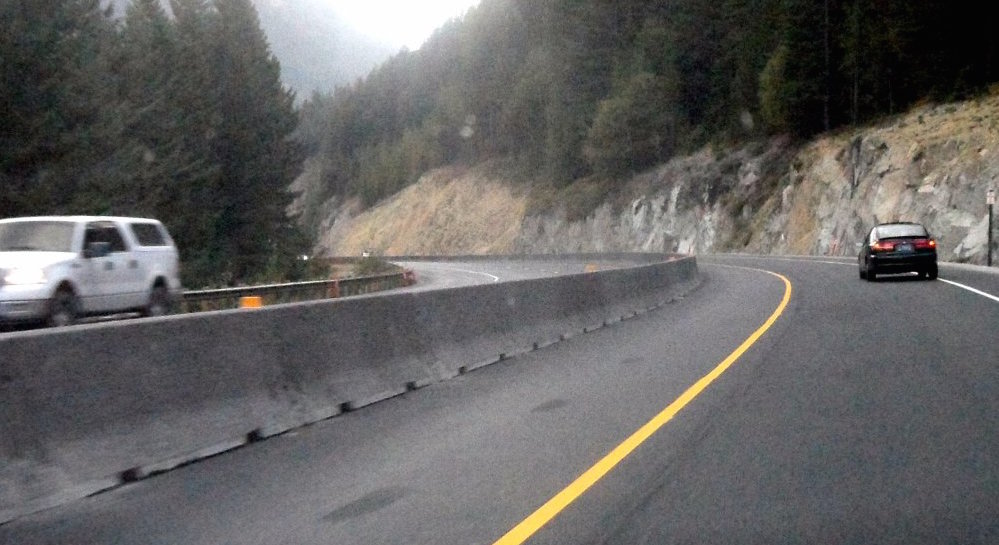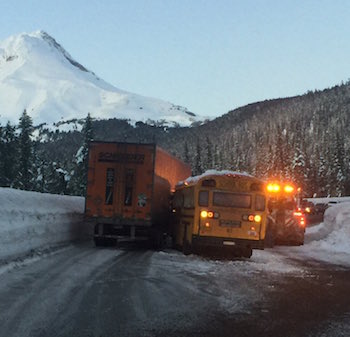So how many accidents and spin-outs did you count on Hwy 35 between Government Camp and Mt. Hood Meadows Sunday morning, December 4th?
50?
75?
100?
There were definitely a lot of cars stuck in snowbanks, and a lot of fender-benders that day. The Oregon Department of Transportation shut down Hwy. 35 entirely Sunday morning to clean up the mess and clear the roads after a barrage of accidents including a crash that injured an ODOT employee. That was good news for those of us fortunate enough to be up in the powder early, with limited crowds due to the closed road. But it was very bad news for the hundreds if not thousands of people stuck on icy roads, waiting in a stagnant line of vehicles stretching 5-10 miles back.
A Large Question
We’ve seen this situation before on Mount Hood, and it raises a large question:
Does ODOT plan for predictably busy winter weekends by de-icing roads and applying gravel BEFORE thousands of travelers come hurling up the mountain in search of fresh snow?
And if not, why not?
Granted, there is nothing ODOT can do about freezing rain. The freezing rain that coated Mount Hood with a shell of ice Friday night and Saturday morning turned parking lots and roads into skating rinks. Melting all that ice is a large undertaking. But isn’t that ODOT’s job? A lot of hours passed between when the freezing rain fell and Sunday morning.
And yes, some accidents can indeed be blamed on unprepared drivers who pound on the brakes too hard and spin out too readily. As we have seen in Oregon over these past two unusually cold weeks, local drivers are not exactly stellar in winter conditions, and road crews are basically unprepared to deal with winter. But not all spin-outs can be prevented with new snow tires, chains and winter driving experience. When you see people get out their cars to push and immediately fall on the ice, you know the roads are downright hazardous.
Fortunately, none of the accidents I witnessed that Sunday morning appeared to result in serious injuries. But I later learned of at least one serious multiple-vehicle crash that did cause injuries, including a broken leg of an ODOT employee on the scene to provide assistance.
From what I saw and heard, most people were not driving fast at all, maybe 30 miles an hour tops. The roads were so icy that they were hazardous at all speeds. ODOT came in with de-icing chemicals and gravel, but it sure would have nice if they had taken that step ahead of time instead of after the fact.
So what is ODOT’s policy on de-icing state highways on Mount Hood?
This morning I sent the following e-mail to three representatives from ODOT:
Hi Don, Michael and Kimberly,
The questions I would like to address in an article for Shred Hood:
-
- How long was Hwy. 35 closed on Sunday?
- Why was it closed?
- How many accidents occurred on Highway 35 Sunday morning?
- How many de-icing rigs does ODOT have available for Mount Hood?
- What is ODOT’s basic policy for de-icing mountain roads in winter?
- Oregon doesn’t allow the use of road salt, correct? In lieu of salt, are there chemicals available that melt snow without causing environmental damage?
- Does ODOT take into consideration the large number of expected winter travelers at 7-9 am Saturdays and Sundays? Is there a policy in place to complete de-icing prior to the winter sports rush hour?
- Who is in charge of policing 35 and 26 to enforce safe driving laws?
Ben Jacklet
Editor, Shred Hood
ODOT’s Response
Within a half hour of sending out the above e-mail, I received a phone call from ODOT Public Information Officer Don Hamilton. He explained that Hwy. 35 was closed for about an hour Sunday morning, up until 10:10 am, due to numerous accidents including several crashes that involved injuries. Oregon State Police and ODOT needed to get emergency vehicles into the area and address the worst areas of the road, so they shut down the road temporarily.
As for ODOT’s de-icing policy, Hamilton explained that highway crews use plows, sand and magnesium chloride as needed. Each maintenance yard determines its own tactics to deal with the roads; there is no centralized command to set strategy. The sand ODOT uses is actually closer to gravel, and it is most effective when applied after the snow has stopped (it was still snowing quite hard on Sunday morning). Applying and removing gravel is a six-step process that needs to be done correctly to avoid clogging drains and littering the highway. “You have to use a lot for it to work, and you have to sweep it up,” Hamilton says. “We sweep as soon as the storm subsides and the weather allows it.”
Spraying magnesium chloride is also a more complex process than you might think. “Applying de-icer is more of an art than a science,” Hamilton says. The chemicals work best when applied to dry pavement, so they can reduce the adhesive bond between the pavement and the ice. They do not work well at low temperatures colder than 15 degrees Fahrenheit, and they do not work at all when it is raining. If you apply de-icer during a storm you risk of wasting a lot of money because the chemicals wash away before they accomplish anything.
Another ODOT PIO, Dave Thompson, explains that sometimes ODOT crews will combine sand and magnesium chloride simultaneously, and that can prove effective, but only if the bulk of the storm has passed. That’s what de-icing teams were out doing on Sunday evening—and perhaps what they should have been out doing Saturday night. “We attempt to get out ahead of all these storms,” says Thompson. “But once that ice has hit there’s just not anything anybody can do until the storm subsides. We’re always going to be behind during the storm. And nobody can drive on freezing rain. Some of us can drive on snow, but nobody can drive on ice.”
Basic road salt, arguably the most effective tool in fighting ice, has not been used traditionally in Oregon due to its effects on water quality and the environment, not to mention how badly it rusts vehicles. Oregon has been experimenting with salt in two pilot projects near the borders with Idaho, Nevada and California (states where salt and/or salt brine is used to prevent ice), but there are no plans to start using rock salt on Mount Hood.
It does need to be said that the widely held belief that Oregon does not use salt on its roads is simply untrue. Magnesium chloride is a salt. It is harvested from brine and sea water in locations such as the Great Salt Lake in Utah and used to control, dust, erosion and ice. As is the case with basic road salt, magnesium chloride has environmental effects on plants, animals and water tables, and it is highly corrosive in concentrated form. It is sometimes presented as a more effective environmentally friendly ice-melting alternative to basic road salt, but whatever advantages it has may be offset by magnesium chloride’s tendency to function poorly in wet climates such as Oregon’s.
As for the matter of enforcing safe driving laws on Hwys. 35 and 26, Hamilton points out correctly that those are questions for the Oregon State Police, and they will be the subject of a follow-up article on Shred Hood.
And finally, credit where credit is due: Ever since the massive mess of December 4, ODOT has done an excellent job of plowing and sanding Mount Hood’s main roads early, before the arrival of the snow-hungry masses. The fender-benders and spin-outs continue, but at nowhere near the volume seen that icy morning.
Be safe out there!
Last modified: December 5, 2016



